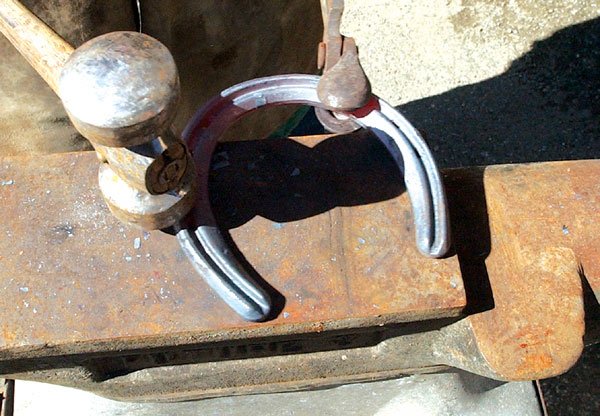There’s a breed of self-employed wanderers in the South Valley
that aren’t listed in the phone book.
Instead, their business comes from word of mouth generated by
their pride in craft and workmanship.
There’s a breed of self-employed wanderers in the South Valley that aren’t listed in the phone book.
Instead, their business comes from word of mouth generated by their pride in craft and workmanship.
Farriers – tradesmen and women who practice the centuries-old art of horse-shoeing and hoof care – earn a quiet living making the lives of some heavy four-legged friends just a little more comfortable.
They spend their days on ranches and in pickup trucks and bent over hot forges, hammer and shoe in hand, creating custom-fitted shoes to cap the hooves of their clients.
To a horse, they are a Nike designer, manufacturer and fitter all in one.
“If you’re shoeing the horse properly, you can get the horse to reach its best, its max,” said Nick Crane, a Gilroy-based farrier who works throughout the South Valley. “We’re not talking seconds (off a barrel racing time), but it helps them stay under themselves so they can stay balanced or stay with it just a little bit better.”
In the world of competitive horsemanship, the shoeing process is a must, and farriers can give equine athletes the support and equipment they need for specific tasks, like lightweight aluminum shoes for jumpers, heavy steel to encourage the action of high-stepping park horses and traction-aiding shoes for endurance horses who compete in 50 to 100 mile trail rides.
There are even slick shoes for Western show horses who perform sliding stops as part of their judged activities.
In most cases, a shoe is attached by forming it to the shape of the hoof, then nailing it in place.
Though a horse may be moving or jerking around at the time, correct placement is key.
Strike too far toward the edge of the hoof and the nail could tear out and cause the loss of a shoe. Strike too far toward the center and the horse can experience pain and discomfort as the nail is driven into the softer part of its hoof.
Most of this discomfort is mild and temporary, but the process has come a long way since its founding days in Europe and Britain.
An organized group of craftsmen as early as 1356, according to the American Farrier’s Association, the farrier’s trade declined precipitously in Europe and the Americas after the development of mechanized farming equipment, but the pleasure horse industry revived interest and the need for tradesmen in the United States, said Alice Johnson, a Morgan Hill-based farrier who has been in the trade for 25 years and is a fixture on the competitive farrier’s circuit, judging shoeing competitions and giving clinics around the country.
“In this country, we never totally lost our horses,” said Johnson. “In Europe and Britain, there was a period of time when your horses were the life of the farm. They plowed fields all day and provided transportation. When the tractors came in, those horses started getting eaten. A lot of the farriers at that time became mechanics, and there was a period of time when the craft was just sort of lost.”
As draft and driving horses came into vogue during the late 1970s and early ’80s, the craft found new life as young, competitive farriers began reviving the old methods of pounding horse shoes from flat or rod-shaped steel stock. A wave of innovation, from new metals to improved tools has flowed from there, said Johnson.
“You would think that something that’s as old as shoeing horses, wouldn’t change so much in 20 years,” said Johnson. “The tools that we have to build the shoes are so much better and the so much more refined.”
Today, horseshoes are made of everything from steel and aluminum to titanium, rubber and plastic, and the science itself has been refined, but classic methods are still favored by most farriers, said Johnson, because glues and other adhesives simply don’t work as well as nailing on the hooves the old fashioned way.
The most modern conveniences most farriers use are pre-formed shoes that they can simply reshape rather than hammering a new shoe entirely from scratch.
Regular farrier visits aren’t just for highly active horses. Hooves are like fingernails in that they are constantly growing, and if a horse is not active enough or fit enough to wear down that matter on their own, the hoof grows out.
And rather than growing straight down, hooves grow forward, too. This forces the horse to stand and walk differently, altering its posture in ways that can lead to imbalance and lameness, said Crane.
Problems like cracked or torn hooves can develop as well, said Johnson, who noted that neglect is the number one reason for horses to become lame but that cracking and splitting on the hoof can also be caused by extreme changes in environment like movement between a very wet and very dry area.
Trimming hooves or reshoeing a horse about once every six weeks can dramatically increase the animal’s comfort level. Shoeing a horse can run between $110 and $150 per shoeing visit, Crane said.
“Most horses, if they’re getting ridden pretty regularly, are fine with just a trim,” he said. “It depends on the use and the terrain.”
Crane takes roughly one hour to fit shoes to a horse, carefully lifting each foot to a height the horse feels comfortable with, then cleaning and inspecting the hoof before deciding on his course of action.
Keeping the horse’s comfort and safety in mind, as well as staying calm and cool, help both horse and farrier to stay safe, even though farriers work right next to the powerful legs of an animal that usually weighs more than 1,000 pounds in adult form.
“I talk with the client, ask whether there’s anything special I need to know about the horse, any previous problems or bad behaviors,” said Crane. “You kind of get to know what’s going to happen when you’re under the horse that much. You feel the horse when it starts to get agitated or aggravated. That’s not to say that I never get stepped on or kicked or bit, but when you make the horse comfortable, you reduce the risk of those things.”
Crane has been shoeing horses for three years now, including the time he’s spent apprenticing under Johnson, and is working at slowly building his own business by word of mouth and referral.
That’s the way most farriers acquire clients, according to Crane and Johnson, and owners may do well to go with farriers whose names they’ve heard from other horsemen, but it doesn’t hurt to check into the farrier’s experience and schooling.
No formal credential is required to practice the craft of shoeing in the United States, unlike some other countries which require extensive apprenticeships or national certification.
However, farriers can be questioned as to which schools they’ve attended, what kind of continuing education they’ve sought and which professional organizations they belong to.
“I’d ask about continued education and whether they go to clinics,” said Johnson. “The American Farriers Association has a certification program. That’s all voluntary, but if the farrier’s gone and taken the time, you know they’ve passed a certain level of skill to get that certification.”
Recommendations, however, are the best way to find a qualified farrier as few of them advertise anywhere, said Crane.
Should a horse lose its shoe without damaging the hoof, owners are best advised to wrap the leg and put an EZ-boot on the site, then call their farrier and ask for a visit in the next couple of days, said Crane. Otherwise, try for same-day help, he said.












